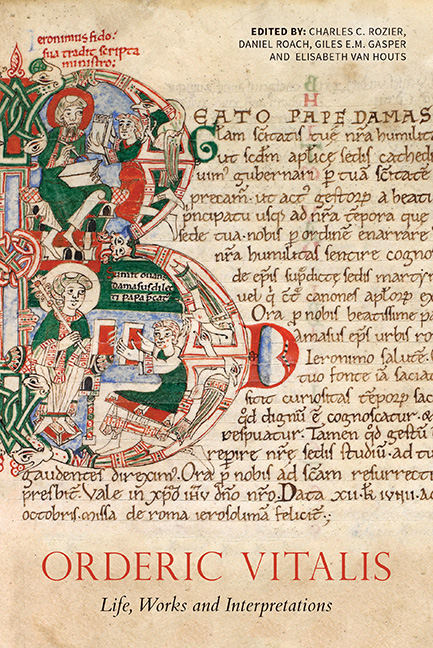Book contents
- Frontmatter
- Dedication
- Contents
- List of Illustrations
- Acknowledgements
- List of Abbreviations
- Chronology of the Lives of Odelerius and his Son Orderic Vitalis
- Composition of the Historia ecclesiastica
- Introduction: Interpreting Orderic Vitalis
- Orderic and his Father, Odelerius
- Following the Master's Lead: The Script of Orderic Vitalis and the Discovery of a New Manuscript (Rouen, BM, 540)
- Orderic Vitalis as Librarian and Cantor of Saint-Évroul
- Saint-Évroul and Southern Italy in Orderic's Historia ecclesiastica
- Orderic and English
- Inscriptions in Orderic's Historia ecclesiastica: A Writing Technique between History and Poetry
- Reading Orderic with Charters in Mind
- Orderic Vitalis and the Cult of Saints
- Orderic's Secular Rulers and Representations of Personality and Power in the Historia ecclesiastica
- Worldly Woe and Heavenly Joy: The Tone of the Historia ecclesiastica
- Orderic Vitalis, Historical Writing and a Theology of Reckoning
- Jesus Christ, a Protagonist of Anglo-Norman History? History and Theology in Orderic Vitalis's Historia ecclesiastica
- ‘Studiosi abdita investigant’: Orderic Vitalis and the Mystical Morals of History
- Meanders, Loops, and Dead Ends: Literary Form and the Common Life in Orderic's Historia ecclesiastica
- Orderic and the Tironensians
- ‘One single letter remained in excess of all his sins …’: Orderic Vitalis and Cultural Memory
- The Reception of Orderic Vitalis in the Later Middle Ages
- Appendix 1 Archaeological Investigations at the Abbey of Saint-Évroult-Notre-Dame-des-Bois
- Appendix 2 Descriptive Catalogue of Manuscripts Featuring the Hand of Orderic Vitalis
- Select Bibliography
- List of Manuscripts Cited
- General Index
Inscriptions in Orderic's Historia ecclesiastica: A Writing Technique between History and Poetry
Published online by Cambridge University Press: 25 October 2017
- Frontmatter
- Dedication
- Contents
- List of Illustrations
- Acknowledgements
- List of Abbreviations
- Chronology of the Lives of Odelerius and his Son Orderic Vitalis
- Composition of the Historia ecclesiastica
- Introduction: Interpreting Orderic Vitalis
- Orderic and his Father, Odelerius
- Following the Master's Lead: The Script of Orderic Vitalis and the Discovery of a New Manuscript (Rouen, BM, 540)
- Orderic Vitalis as Librarian and Cantor of Saint-Évroul
- Saint-Évroul and Southern Italy in Orderic's Historia ecclesiastica
- Orderic and English
- Inscriptions in Orderic's Historia ecclesiastica: A Writing Technique between History and Poetry
- Reading Orderic with Charters in Mind
- Orderic Vitalis and the Cult of Saints
- Orderic's Secular Rulers and Representations of Personality and Power in the Historia ecclesiastica
- Worldly Woe and Heavenly Joy: The Tone of the Historia ecclesiastica
- Orderic Vitalis, Historical Writing and a Theology of Reckoning
- Jesus Christ, a Protagonist of Anglo-Norman History? History and Theology in Orderic Vitalis's Historia ecclesiastica
- ‘Studiosi abdita investigant’: Orderic Vitalis and the Mystical Morals of History
- Meanders, Loops, and Dead Ends: Literary Form and the Common Life in Orderic's Historia ecclesiastica
- Orderic and the Tironensians
- ‘One single letter remained in excess of all his sins …’: Orderic Vitalis and Cultural Memory
- The Reception of Orderic Vitalis in the Later Middle Ages
- Appendix 1 Archaeological Investigations at the Abbey of Saint-Évroult-Notre-Dame-des-Bois
- Appendix 2 Descriptive Catalogue of Manuscripts Featuring the Hand of Orderic Vitalis
- Select Bibliography
- List of Manuscripts Cited
- General Index
Summary
Orderic Vitalis's composition of his Historia ecclesiastica is characterised by his insertion of ‘exogenous’ documents throughout his narrative. Over 100 sources appear in this way, including theological, literary and historical works from the abbey library, and legislative and diplomatic texts. One of the most common types of source used in this way is epigraphic texts. Thirty-eight epitaphs commemorating Anglo- Norman lay or clerical aristocrats are dotted throughout the Historia ecclesiastica, from Book IV onwards (the first three books do not contain any). Unevenly distributed throughout the different books, the epitaphs appear only in sections depicting events contemporary to Orderic, concerning the north of France or England, or tracing the history of Norman monasteries, their founders or benefactors. The inscription is, therefore, just one kind of writing among many others within the Historia ecclesiastica, but one that Orderic appears to have known well and particularly liked deploying, in a variety of contexts and for a variety of purposes.
The eleventh and twelfth centuries mark the peak of the popularity of the epitaph as a poetic genre among Latin authors of the Middle Ages. Baldric of Bourgueil, Hildebert of Lavardin, Foulcoie of Beauvais and, to a lesser extent, Marbodius of Rennes wrote several dozen of these metric compositions. Mortuary rolls, which flourish during the same period, show another way to express funeral poetry. The epitaph itself can be considered the monumental version of the eulogy and planctus, stripped back to its basics. Individual examples vary greatly in the tone of the eulogy, the length of the text, and the themes emphasised. There are, however, a number of rules which seem to have been observed, and which need to be taken into account. The poems always contain both a death notice (sometimes with a precise date) and information about the tomb (for example, a reference to the funeral monument or the context of the burial). They almost always end with a prayer request to the reader and/or a pious wish that the soul of the deceased might be saved.
The literary epitaph has a number of similarities with the funerary inscription in verse, which had existed in the form of epigraphic texts since classical antiquity, but enjoyed a revival in the Middle Ages.
- Type
- Chapter
- Information
- Orderic Vitalis: Life, Works and Interpretations , pp. 127 - 144Publisher: Boydell & BrewerPrint publication year: 2016



